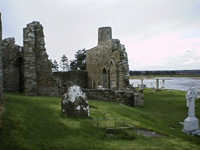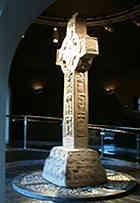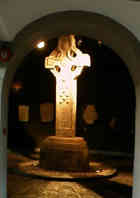The ancient monastic site of Clonmacnoise is situated at the
crossroads of Ireland in County Offaly and dates back almost 1,500 years.
St. Ciaran, the son of an Ulsterman who had settled in Connaught, chose the
site in 545 AD because of its ideal location at the junction of river and
road travel in Celtic Ireland. The location borders the three provinces of
Connaught, Munster and Leinster.
The monastery is on the east side of the River Shannon, in
what was then the Kingdom of Meath, but occupying a position so central it
was the burial-place of many of the kings of Connaught as well as those of
Tara.
Saint Ciaran was educated by St. Diarmuid of Clonard and
St. Finian - tutor of the ancient Saints of Ireland. His last place of
formal learning before establishing his own monastery in Clonmacnoise was
with St. Enda on the island of Inís Mór off the coast of Galway. Here,
under the tutelage of the strict disciplinarian Enda, he learned Sacred
Studies, Prayer and labour.
(For centuries courting couples
stood each side of the arch whispering their words of love to each other)
Shortly after his arrival, Ciaran met Prince Diarmuid who
helped him build the first church - a small wooden structure and the first
of many small churches to be clustered on the site. Diarmuid was to be
crowned the first Christian High King of Ireland. Ciaran
did not live to see his monastery grow and flourish.....he died of yellow
plague 4 years after settling at 33 years old.
The monastery attracted many of the scholars of Ireland
and from across Europe and it was to become the most illustrious school in
Europe. It was a Scriptorium from the 8th.-10th.
centuries and many scribes toiled long hours learning the skills
to become world renowned in works such as the Books of Kells and Durrow.
Metal workers in gold, silver and bronze produced some of the world's finest
Celtic craftwork, not surpassed since the 11th. century.
No single large church exists, or ever existed, at
Clonmacnoise, but instead there were several small churches of simple plan
and wooden construction. There is no evidence
left of the monks' living quarters. It is presumed the whole complex was
enclosed by a rampart of earth or stone. Standing on the site now is a
cluster of ruins within the graveyard that were built from the 12th century
onwards.
The monastic settlement has seen many violent and
destructive periods in its history and was destroyed by fire at least 13
times. It was attacked approximately 40 times from the 8th. to the 12th.
century, 8 times by the Vikings, 6 times by the Anglo Normans and 26 times
by the Irish. Each time the Monks rebuilt.
In 1552 it was finally reduced to ruin by the English
garrison in Athlone. From that time there were no monasteries in
Ireland for almost 300 hundred years. Clonmacnoise lay in decay until the
Office of Public Works began the arduous task of turning this place into one
of Ireland's most famous visitors' centers.

Remains of The Cathedral
The North and South Crosses are made from
quartzose sandstone found at the foot of the Bernagh mountains near Lough
Derg. The stone used in this craftwork was transported by boat up the Lough and the river Shannon to the site.
Both crosses and other invaluable stonework are now housed in a heritage center
designed to resemble crannogs. Crannogs were the living quarters in ancient Celtic
settlements and were circular in construction.


|
The South Cross
|
The North Cross
|
The preservation work is carried on by Duchas - the
National Heritage Service. Clonmacnoise ranks as one of Ireland's most
spectacular and valuable heritage sites and is located about 12 miles from
both Athlone town and Ballinasloe in County Galway. The nearest village is
Shannonbridge but it is not an easy place to get to, especially for those
who do not drive or only have access to public transport.
Next
->
